9 May 2019 | Awards, Fellowship, Fellowship 2018, News and features
[vc_row][vc_column][vc_column_text]
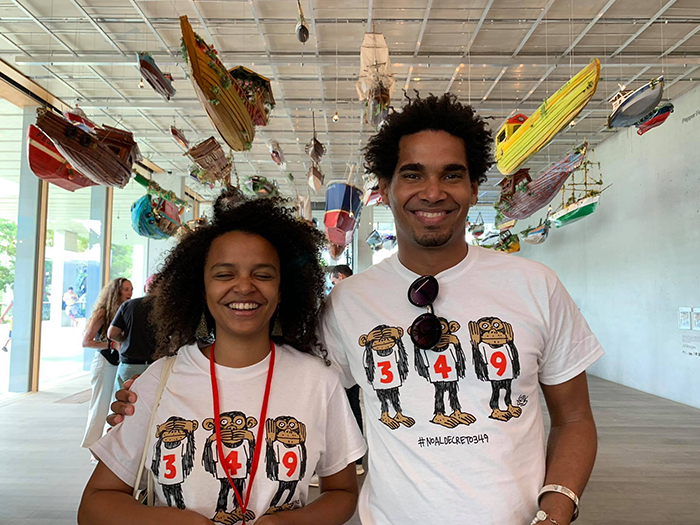
Cuban artists Luis Manuel Otero Alcantara and Yanelys Nuñez Leyva, members of the Index-award winning Museum of Dissidence
Yanelys Nuñez Leyva and Luis Manuel Otero Alcántara, members of the 2018 Index on Censorship Freedom of Expression Award-winning Cuban artist collective the Museum of Dissidence, have been putting themselves on the line in the fight for free expression in Cuba, from being harassed by the authorities to their numerous arrests for protesting Decree 349, a vague law intended to severely limit artistic freedom in the country.
Cubans voted overwhelmingly for a new constitution that upholds the one-party state while claiming to bring about some economic and social reform, but the Museum of Dissidence took a more critical stance to the referendum. Index caught up with Nuñez Leyva and Otero Alcántara to talk about the current situation in Cuba and what they’ve been up to recently.
Index on Censorship: Why did the Museum of Dissidence and its members come out so strongly against the new Cuban constitution?
Luis Manuel Otero Alcántara: The constitution imposed by the regime is an aberration that goes against the freedom of the Cuban and does not represent us as Cubans, intellectuals or humans. The Magna Carta should not be written to control and cut my freedom, it must represent a balance of citizen welfare especially for the immediate future.
Index: Decree 349 will see all artists prohibited from operating in public places without prior approval from the Ministry of Culture. How does this impact the work you do?
Otero Alcántara: The campaign against the 349 was a great victory, the regime had to admit that it was wrong. The country’s leaders had to face and make political moves to placate countless artists, intellectuals and ordinary people concerned about Cuban culture and who joined in the demands to the regime.
Given this, the 349 helped to make visible all the repression and censorship that the government has been carrying out against culture and art for 60 years. As a legacy, we left the movement of San Isidro, a group of artists and intellectuals that has the mission to overcome all the inhumane repression of the regime, to be vigilant and proactive over freedom of Cuban art and culture. The most important project of the post-campaign movement 349 will be the Observatory of Cultural Rights in Cuba.
Index: What sort of training did Yanelys Nuñez Leyva receive while in Prague as part of the Freedom of Expression Awards Fellowship and how will it be useful in Museum of Dissidence?
Yanelys Nuñez Leyva: The training covered tools I can use for work, such as video editing. It also offered insight into new topics such as feminism, a social movement that is not yet as strong in Cuba but should be.
Index: What did Museum of Dissidence do while in Mexico at the Oslo Freedom Forum and how will this help further your cause?
Otero Alcántara: The MDC joined several independent institutions in Cuba such as the Matraca Project, or the Endless Poetry Festival, so that each one, from his or her experience, would demand freedom of expression for all Cubans in a forum.
In all the presentations, we emphasised the unjust detention of two Cuban musicians, Maikel Castillo and Pupito, who are imprisoned for opposing Decree 349.
Index: How did attending Libertycon in Washington DC reinforce or re-inspire your fight for artistic freedom in Cuba?
Luis Manuel: All these events we have been a part of, such as Forum 2000, or the Index award, or the residency in Metal, have helped to create a platform where contemporary art ceases to be an ornament in a house but an exercise of pressure and a true link of change within Cuba.
Index: Although nearly 87% of voters in the referendum voted yes to the new constitution, there was an unprecedented display of ballot-box dissent, with more than 700,000 people voting no. What do you think this is a result of and do you think this signifies changing times for the Cuban population and government?
Otero Alcántara: In a totalitarian regime like the one in Cuba, where it controls all the information, international observers and legal transparency systems are not allowed, those percentages are strategies of the regime to simulate a less critical state than the one that exists. Those numbers are a joke but the interesting thing is to see how the political opposition handles that ‘no.’ Making ordinary people see that they are not alone, that other thousands of people feel and voted just like them, is something that contributes to encouraging dissent.
Index: What makes you remain so steadfast in your fight for artistic expression in Cuba when the oppression of artists continues, including the recent arrest of members of the Museum of Dissidence?
Otero Alcántara: Love binds me, wherever I want to escape, from the shelter of the pillow in the darkness of my room; going through a luxurious hotel in Miami or in a bucolic countryside in the UK, the suffering of Cuba and the human is shaking my head and the only way I can free myself from that ghost is to fight and know that I am doing something.
Last December when the government promised to implement the 349, I felt that my spirit was imprisoned in the body of a regime, so I took responsibility for the life of my body through a hunger strike to the regime. It would be they who would decide if I was still breathing my body or not but my spirit would be free.
Luckily, we got a reaction from the government. They appeared on Cuban television, and that was because of the union that was achieved among all the artists.
Index: What are the main goals that you’ll be working toward throughout 2019?
Otero Alcántara: 2019 is the year of the official state-sponsored Havana biennial and a year of preparation for the #00 Biennial of 2020, which are two interesting scenarios for the future of Cuban culture right now. The other thing is to continue working for overall freedom in Cuba.
Index: How has the Museum of Dissidence benefitted from its time on the Index on Censorship Freedom of Expression Awards Fellowship?
Otero Alcántaral: Being Index Fellows was one of the best things that has happened to the museum in its history as a work of art and an institution. It was a prize that gave visibility to the Musem of Dissidence and gave us thousands of contacts. It gave us protection against the repression of the regime and its discredit toward political art in Cuba. But above all we met people like Perla Hinojosa and the rest of the Index team, also Mohamed Sameh from ECRF, Julie Tribault, the promoters of the Metal artistic residency and another large number of projects and platforms that, with their example, have encouraged us to continue the struggle, especially in the moments of greatest loneliness.[/vc_column_text][/vc_column][/vc_row][vc_row][vc_column][vc_basic_grid post_type=”post” max_items=”4″ element_width=”6″ grid_id=”vc_gid:1583501159250-00b68107-bcde-1″ taxonomies=”7874″][/vc_column][/vc_row]
15 Apr 2019 | Americas, Awards, Campaigns -- Featured, Cuba, Fellowship, Fellowship 2018
[vc_row][vc_column][vc_column_text]
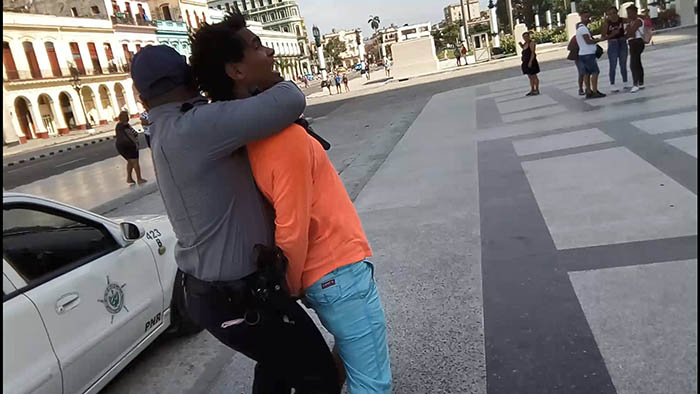
Cuban artist Luis Manuel Otero Alcantara being arrested in August 2018
Index on Censorship calls for the immediate release of Cuban artist Luis Manuel Otero Alcantara, a member of the 2018 Index on Censorship Freedom of Expression Award-winning Museum of Dissidence. This is the second time he has been arrested in two weeks.
Otero Alcantara was performing a homage to Daniel Llorente, which involved a footrace with American flags outside his home. Llorente demonstrated with the American flag in 2017 during Havana’s annual May Day celebrations. Otero Alcantara was detained along with two other artists and his whereabouts is currently unknown.
The head of Cuba’s National Council of Visual Arts, Norma Rodriguez, told Reuters in a press conference that Otero Alcantara “is an activist, not an artist”.
Michel Matus, an artist who captured Otero Alcantara’s arrest on video, wrote a statement on the harassment and threats he faced for filming and for being part of the campaign against Decree 349, a law that criminalises independent artists and places severe restrictions on cultural activity not authorised by the state. Matus was called into a police station to show the deeds to his home to prove ownership. He was interrogated for over nine hours about the campaign, his family and Otero Alcantara.
“Artists should not be criminalised for freely expressing themselves,” said Index on Censorship CEO Jodie Ginsberg. “The Cuban government should immediately release Luis Manuel and other jailed artists and end its repressive intimidation tactics.” [/vc_column_text][/vc_column][/vc_row][vc_row][vc_column][vc_basic_grid post_type=”post” max_items=”4″ element_width=”6″ grid_id=”vc_gid:1555338145410-bdabf8fe-1d1a-7″ taxonomies=”7874″][/vc_column][/vc_row]
12 Apr 2019 | Americas, Campaigns -- Featured, Cuba
[vc_row][vc_column][vc_column_text]
Index on Censorship, Pen International and Artists at Risk Connection of Pen America stand in solidarity with independent Cuban artists as the 13th Havana Biennial, which begins in the Cuban capital on 12 April and ends 12 May 2019.
The month-long, state-sponsored biennial will showcase the work of international and Cuban artists who are officially-recognised by the Cuban Ministry of Culture.
We, the undersigned organisations, call on the participating artists to support the campaign against the country’s Decree 349. Building upon existing laws and regulations that apply to artists officially recognised by the Cuban government, Decree 349 formalises and widens the scope of artistic censorship in Cuba and creates a new category of art inspectors with the power to unilaterally impose fines, cancel events, and subject artists to asset forfeiture as a penalty for presenting work without authorisation from the state.
Independent artists who have peacefully protested the decree have faced persistent harassment, including repeated arbitrary detentions. Artist Luis Manuel Otero Alcantara was detained last week and again this week. Coco Fusco was denied entry into the country while a family member of artist Tania Bruguera has been harassed. Meanwhile, rappers “Maykel” Castillo Pérez and Lázaro Leonardo Rodríguez Betancourt “Pupito en Sy” have been held in Valle Grande prison since their arrests in September and November 2018, respectively. Arrested shortly after their participation in a public concert critical of Decree 349, the wider Cuban artistic community believes that the charges laid against them have been fabricated in retaliation for their peaceful protest.
Campaigning artists have asked Biennial participants to express solidarity in any way they feel most comfortable with. Suggestions include inviting independent artists affected by Decree 349 to take part in presentations at the Havana Biennial, or supporting alternative events under the title of “Bienal sin 349”. Other actions showing solidarity for participants can include wearing a “No to Decree 349” t-shirts while in Cuba, or even visiting home studios to learn more about the efforts of independent artists. Independent artists only ask that participants find ways to include them in their experience of the Havana Biennial, as they continue to be marginalised and silenced despite government statements that the decree is part of an inclusive and supportive national cultural policy.
The undersigned organisations call on the Cuban authorities to comply with its international obligations as a signatory to the International Covenant on Civil and Political Rights to ensure that independent artists be given the opportunity to peacefully protest during the Biennial without the fear of arrest or harm. We also call for the release of rappers Maykel and Pupito en Sy, and for the charges to be dropped, if as is suspected, they are being targeted for the peaceful exercise of their right to free expression.
Index on Censorship
Pen International
Pen America – Artists at Risk Connection
Tate Modern
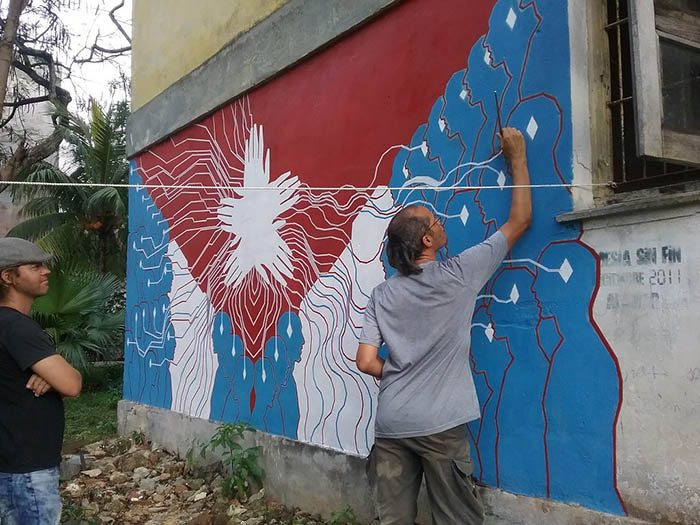
Cuban artist Yasser Castellanos at the 2018 Biennial
An Open Letter from Cuban Arts Professionals to Participants in the 2019 Havana Biennial
We are members of the artist community in Cuba. We are contacting you with the understanding that you have been invited to participate in the 2019 Havana Biennial. As you may know, over the past eight months, a movement has emerged among artists from all disciplines to protest a new law that recently came into effect, known as Decree 349. This law criminalises independent artistic activity and gives art inspectors the right to impose a fine or subject artists to asset forfeiture as a penalty for presenting work without authorisation from the state. The Cuban government created the law without consulting its arts community. We are attaching information about the decree for your review. Please feel free to ask us if you have any questions.
We have been protesting this law through various tactics: some of us have met with government officials to express our opposition to the laws, while others have developed a campaign in social media to foment critical debate about the laws. Many of us have engaged in direct action and have been detained by the Cuban police for attempting to stage a sit-in at the Ministry of Culture in the days leading up to the law going into effect last December. It goes without saying that the government has not been pleased about our protests and has gone to great lengths to characterise us in the Cuban media as counter-revolutionaries and troublemakers who are not worthy of recognition as artists. Nonetheless, it is the first time in almost 60 years that artists from all disciplines, ages and political views have united against a government decree. More than 300 Cuban artists have signed a letter of protest directed to the Ministry of Culture and numerous foreign arts professionals have expressed their solidarity with our cause.
We have not succeeded in getting the government to rescind the law, but officials did announce last December that they would not put the law into effect fully until a set of regulations that are to be discussed with the arts community are finalised. We have not received any further information about those regulations as yet.
We are writing to you to ask for your solidarity and support at a challenging time for Cuban artists. A small gesture of solidarity goes very far in Cuba, particularly in the arts. We are sharing with you a list of artists who are vulnerable due to their protest of Decree 349. We ask you to consider expressing your solidarity in the way you feel most comfortable. We have envisioned several scenarios: You can invite one of the artists affected by the Decree 349 to work with you during your presentation at the Havana Biennial, or you can share part of your exhibition space or stage if you are participating in a public event. You can wear “No to Decree 349” t-shirts while in Cuba to show support for our cause. You can visit us at our home studios to learn more about our efforts. All that we ask is that you find ways to include the artists who are going to be marginalised due to the decree in your experience of the biennial.
As members of a global artistic community, we are all interconnected. Cuban artists have shown their support of other artists in the world when ethically dubious things happen to them. Now we ask for artists to be in solidarity with us, to make Cuba a place in which all cultural expression can thrive.
To contact us please write to: [email protected]
Sincerely,
Lester Alvarez
Italo Expósito
Tania Bruguera
Luis Manuel Otero Alcántara
Yanelys Nuñez Leyva
Amaury Pacheco
Iris Ruiz
Sandor Pérez
Michel Matos
Hamlet Lavastida
Nonardo Perea
Yasser Castellanos
Verónica Vega
Aminta D´Cárdenas
Yoandri Kindelán Sierra
Javier Moreno
René Rodríguez
José Ernesto Alonso
Andrés Pérez
Ariel Maceo Tellez
Abu Duyanah Tamayo
Alejandro Barreras
Francis Sanchez
For more information on Decree 349:
Summary in English: https://frieze.com/article/looking-back-year-art-and-protest-cuba
Artist at Risk Connection white paper Art Under Pressure in English and Spanish[/vc_column_text][/vc_column][/vc_row][vc_row][vc_column][vc_basic_grid post_type=”post” max_items=”4″ element_width=”6″ grid_id=”vc_gid:1556718415064-1beae721-d7d0-2″ taxonomies=”7874″][/vc_column][/vc_row]
11 Jan 2019 | Awards, Awards Update, Fellowship, Fellowship 2018, News and features
[vc_row][vc_column][vc_column_text]
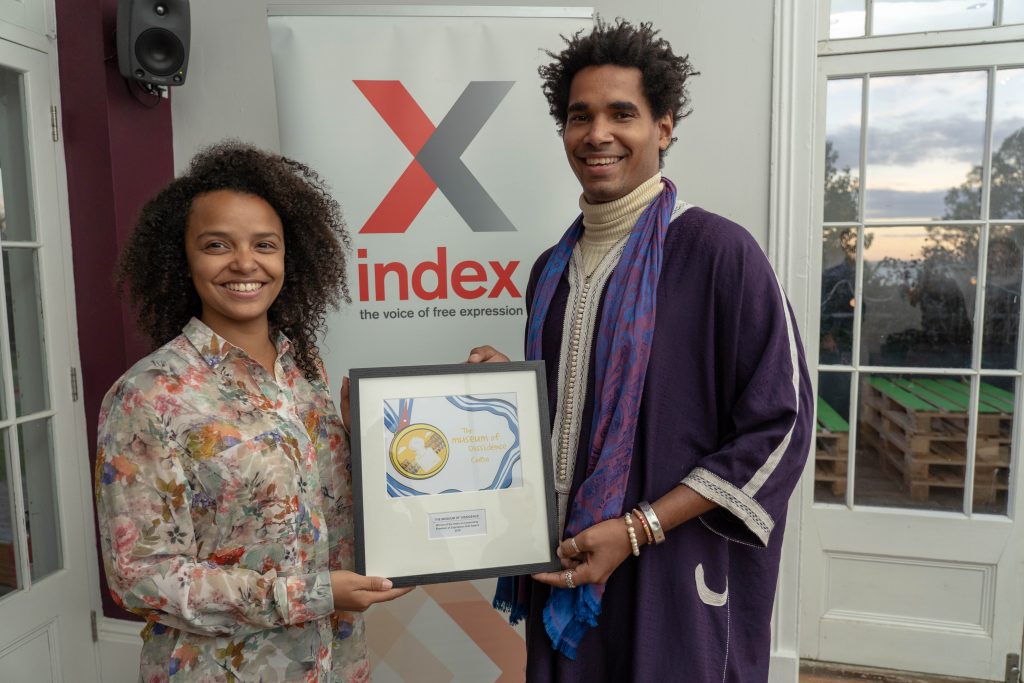
Yanelys Nuñez Leyva and Luis Manuel Otero Alcántara. The Museum of Dissidence
2018 Freedom of Expression Awards at Metal, Chalkwell Park, Essex.
Artistic freedom is under attack in Cuba, but artists are fighting back. Yanelys Nuñez Leyva and Luis Manuel Otero Alcántara, members of the 2018 Index on Censorship Freedom of Expression Award-winning Cuban artist collective the Museum of Dissidence, along with many others, are putting themselves on the line in the fight against Decree 349, a vague law intended to severely limit artistic freedom in the country. Decree 349 will see all artists — including collectives, musicians and performers — prohibited from operating in public places without prior approval from the Ministry of Culture.
“349 is the image of censorship and repression of Cuban art and culture, and is also an example of the exercise of state control over its citizens,” Otero Alcántara tells Index. “Artists, in a spectacular way, must work in a state of double resistance, as artists and as activists, because the system has control over all opportunities for artistic growth.”
For their role in peacefully protesting Decree 349, Otero Alcantara and Nuñez Leyva were among 13 artists arrested, including Cuban performance artist Tania Bruguera, in Havana on 3 December 2018. Index joined others at the Tate Modern in London on 5 December in a show of solidarity with those jailed.
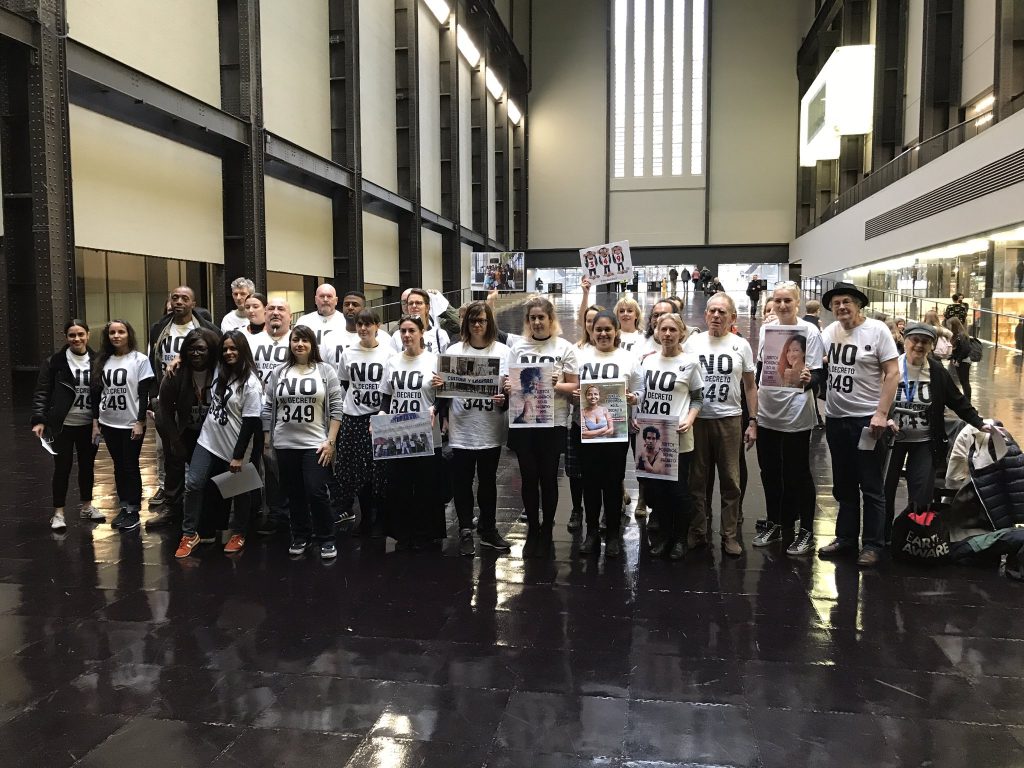
Protest in support of jailed Cuban artists at the Tate Modern gallery, London, October 2018.
On Human Rights Day on 10 December 2017, US Assistant Secretary of State Kimberly Breier tweeted: “[O]ur minds turn to the people of #Cuba, who have endured decades of repression and abuse at the regime’s hands, most recently via the creativity-crushing #Decree349.”
“The international help is positive because it makes visible the abuses of the Cuban regime against the people, but I think we must sacrifice ourselves in body and spirit — in a peaceful way — if we want to achieve our freedom,” Nuñez Leyva tells Index on Censorship. “We are very grateful for any help and pronouncements against 349. The redaction of the decree and the silence of the authorities is demonstrating that in Cuba there is a dictatorial regime in which no type of political, economic or social opening is taking place.”
In the days following all arrested artists were released, although they remained under police surveillance. Cuba’s vice minister of culture Fernando Rojas at the time told the Associated Press that changes would be made to Decree 349 but failed to open a dialogue with the artists involved in the campaign against the decree. A version of the law came into force on 7 December.
“We are determined to continue demanding the full repeal of 349,” Nuñez Leyva says. “We do not want to continue living in this perennial state of vulnerability.”
The persecution of the Museum of Dissidence isn’t limited to arrests. On 9 November Otero Alcántara took to Facebook to call out a campaign to discredit him. State security had been sending texts and holding meetings with his neighbours in what the artist said was a “desperate attempt” to “sabotage our activities”.
“The rhetoric that the government uses is well known to all — that we are mercenaries — and although most people no longer believe it, some of them decide to exclude you because you are a ‘marked’ person like you have a contagious disease,” Otero Alcántara tells Index. “You are a socially excluded and politically persecuted.”
“We try all the time not to give it too much importance, we try to smile because we really do not want to feel any bad energy,” he adds. “Our principle is love, dialogue, peaceful struggle. If they wish to defame us, it is on their conscience, not ours.”

Cuban artists Luis Manuel Otero Alcantara and Yanelys Nuñez Leyva, members of the Index-award winning Museum of Dissidence
Nuñez Leyva describes the efforts to dissuade Cuban artists from protesting 349 — including the seizure of anti-349 t-shirts emblazoned with three wise monkeys when re-entering Cuba after attending the Creative Time Summit in Miami — as “a mechanism to prevent the spread of the truth and above all, to make us tired and to resort to leaving the country”. But the Museum of Dissidence will not be deterred. “To achieve that, they will have to be more vicious.”
“The government spends innumerable resources to repress any type of expression that makes it uncomfortable,” Otero Alcántara says. “It seeks to discredit activists and artists all the time by isolating them from society, from their friends, from their family.”
After a seven-month campaign to attain visas to enter the UK — which saw the Museum of Dissidence denied visas on three occasions, causing them to them miss the Index on Censorship Freedom of Expression Awards ceremony in April 2018 — Nuñez Leyva and Otero Alcántara were finally able to receive their award at Metal Culture, an arts centre in Chalkwell Hall, Southend-on-Sea, on 18 October 2018. The artists were in residence at Metal for two weeks in October as part of their partnership with Index on Censorship.
“Southend-on-Sea generously gave us all its warmth. Staff at Metal, the uncharacteristically warm climate, the brick architecture of the place, the low tide river, the local legends told by a science fiction writer, the banks that paid homage to the deceased, the interest of the local media in the Cuban cause were encouraging for us,” Nuñez Leyva says. “To realise that a calm, inclusive city is possible opens us up and make us less naive when going back to face the Cuban reality.”
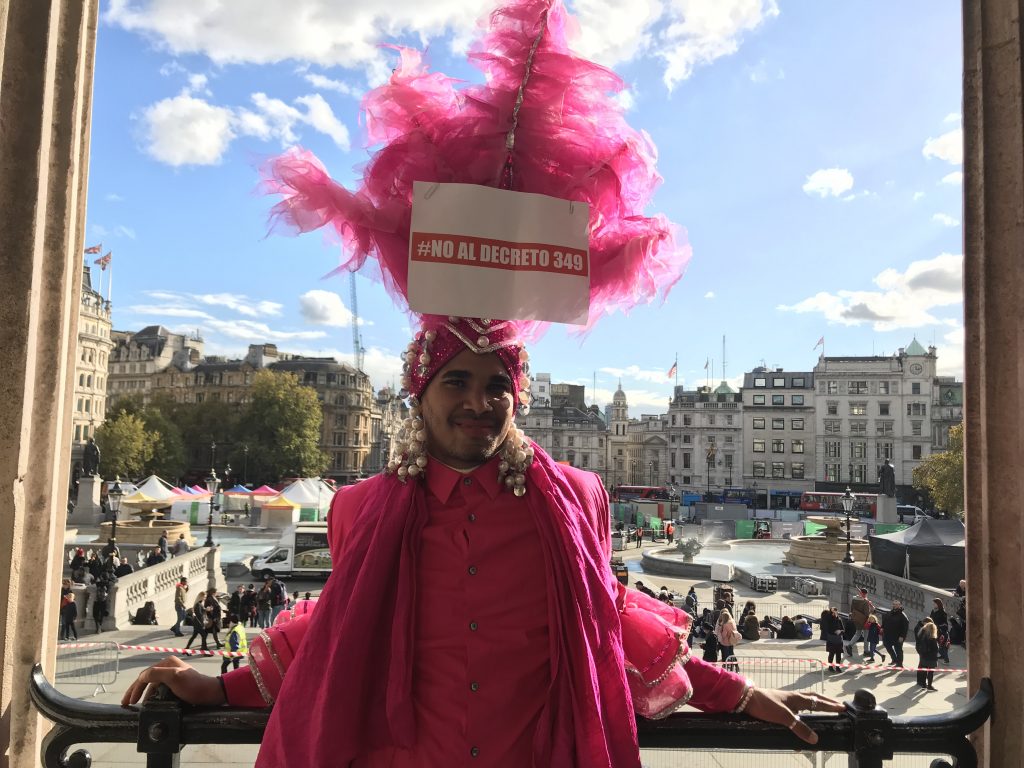
Luis Manuel Otero Alcantara as Miss Bienal
During his time in the UK, Otero Alcántara performed in Trafalgar Square on 26 October as Miss Bienal, a character he created in 2016 to symbolise the mulatto woman typified in clichés by tourist and for artistic consumption.
“Entering the National Gallery in a rumba dress without censorship made us realise the context of freedom and acceptance of difference that is breathed in London,” he says. “London is a giant city with so much art, diversity and history, it makes the body detoxify a bit from the bad energy you get living in a system like the Cuban one.”
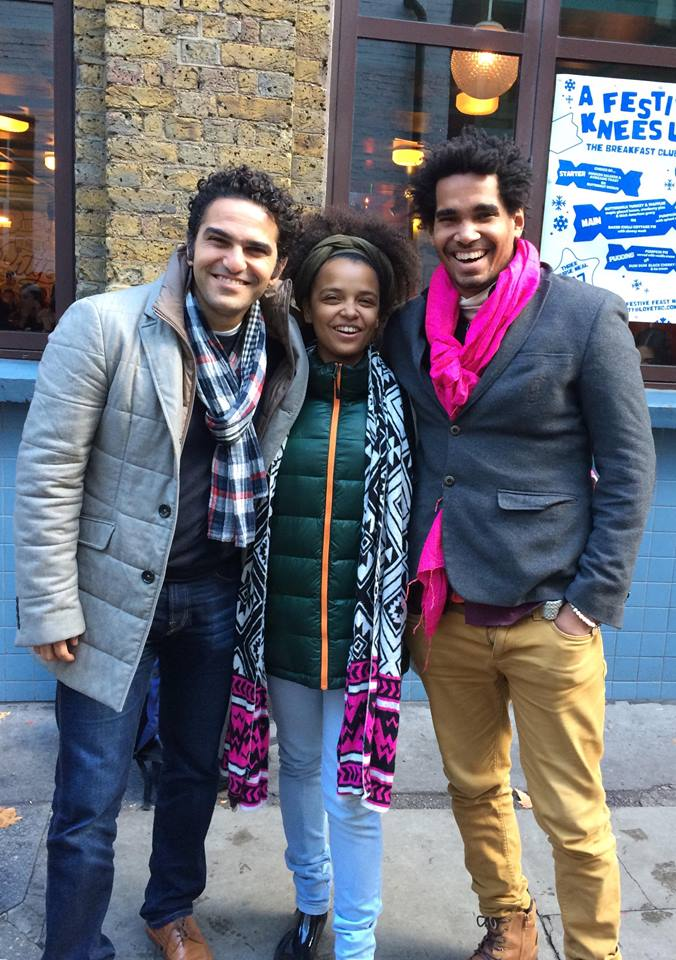
Mohamed Sameh with Yanelys Nuñez Leyva and Luis Manuel Otero Alcantara in London
While in London, the pair met with Mohamed Sameh, co-founder and international relations advisor at the Egyptian Commission for Rights and Freedoms, winner of the 2018 Index on Censorship Freedom of Expression Award for Campaigning. ECRF is one of the few remaining human rights organisations in Egypt, a country that often uses its struggle against terrorism as a justification for its crackdown on human rights.
“We shared with Mohamed the desire for prosperity in our respective countries, but also the smile that we shared, which we hold on to all the time,” Nuñez Leyva says. “The contagious smile of Mohamed is similar to that of, not only of the Museum of Dissidence in Cuba, but also Amaury Pacheco, Iris Ruiz, Coco Fusco, Student without Seed, Michel Matos, Aminta D’Cardenas, La Alianza, Yasser Castellanos, Veronica Vega, Javier Moreno, Tania Bruguera, and other artists who at this moment are fully engaged in the improvement of Cuba.”
“Although our contexts are different, we feel a total empathy with the struggles of Mohamed, because in our work we put ourselves at risk all the time for our rights and total freedom of expression, principles that for Mohamed are also non-negotiable.” [/vc_column_text][/vc_column][/vc_row][vc_row][vc_column][vc_basic_grid post_type=”post” max_items=”4″ element_width=”6″ grid_id=”vc_gid:1547483905239-0a56285c-5eb0-10″ taxonomies=”23707″][/vc_column][/vc_row]








